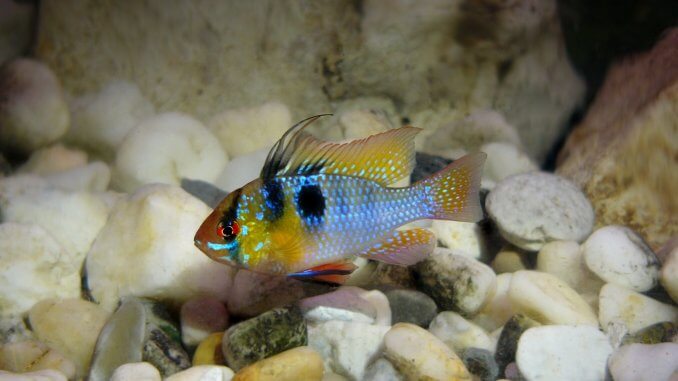
The German blue ram is a freshwater fish of the Cichlidae family. The fish is small, colorful, and has attractive, blue spots across its body.
Unlike most cichlids, German blue rams are peaceful and thrive in community tanks. However, these fish are moderately difficult to care for because they’re sensitive to water fluctuations.
TABLE OF CONTENTS
German Blue Ram Facts & Overview
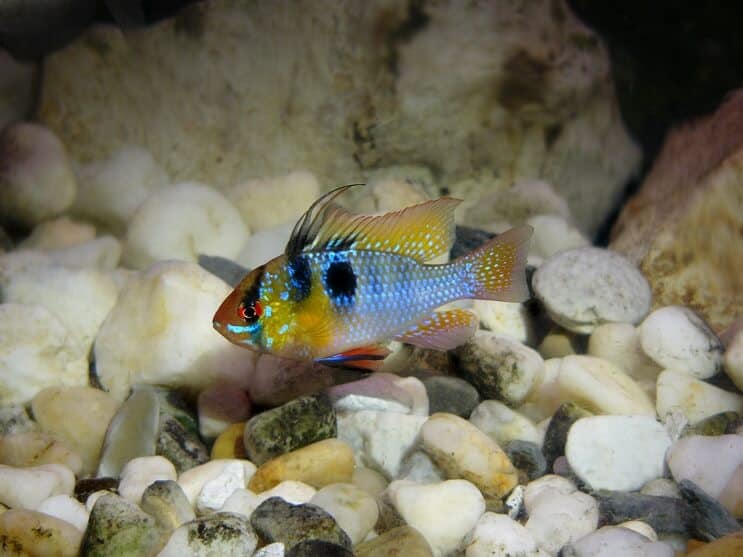
| Scientific name: | Mikrogeophagus ramirezi |
| Common names | German blue ram, ram cichlid, blue ram cichlids, German blue, Asian ram, butterfly cichlid, Ramirez's dwarf cichlid, dwarf butterfly cichlid |
| Distribution: | South America, Orinoco river basin |
| Size: | 2–3 inches |
| Life expectancy: | 2–3 years |
| Color: | Gold or silver body with blues and black markings |
| Diet: | Omnivore |
| Temperament: | Peaceful |
| Minimum tank size: | 20 gallons |
| Temperature: | 80–86°F (26–30°C) |
| pH: | 5.0–7.0 |
| Hardness: | 6–14 dGH |
| Care level: | Intermediate |
| Breeding: | Egg layer |
Origin
German blue rams (Mikrogeophagus ramirezi) are native to South America, where they inhabit the slow-flowing waterways of the Orinoco River basin in Colombia and Venezuela. These bodies of water are warm, acidic, and densely vegetated. The fish favors tannin-stained environments, like Blackwater river, that are sheltered from the sun.
German blue rams have a relatively stable wild population and aren’t considered endangered or threatened. However, most German blue rams in the pet trade are captive-bred because the fish are easy to breed. Several selectively-bred varieties of fish are available.
German blue rams are similar in appearance to their close cousin, the Bolivian ram (Mikrogeophagus altispinosus).
Adult Size & Lifespan
Adult German blue rams grow 2 to 3 inches in length, with males being larger than females. In the wild, German blue rams can grow up to 4 inches.
The German blue ram has an average lifespan of two to three years when properly cared for. The fish’s lifespan depends on its diet, genetics, and living conditions.
Availability
Despite their care difficulty, German blue rams are popular in the pet trade and are widely available in pet stores. These fish typically cost between $8 and $13, with a group of 6 costing around $50. Color morphs and selectively-bred varieties, like electric blue rams and longfin blue rams, are more expensive.
German blue rams are available at these reputable online stores:
Appearance & Behavior
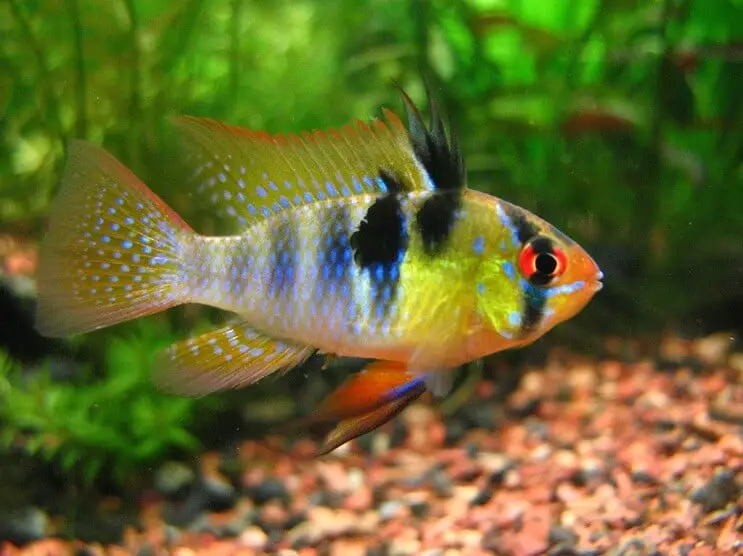
German blue rams have colorful bodies with blue dots, black stripes, and reddish fins. Unlike other cichlids, German blue rams are peaceful and get along well with other fish.
Colors, Patterns, Fins, and Sex Differences
The German blue ram has a yellowish-blue, oval body that’s covered in bright, blue dots. The fish also has a dark vertical stripe that runs through the eyes, and a black blotch in the middle of the body. The fins are spiky, long, and yellow or red, with dark edging. The front dorsal is typically black.
The German blue ram has bright red eyes, which makes the fish look intimidating despite its peaceful nature. The fish’s flank is paler than the rest of its body. Some German blue rams have additional black stripes across their bodies. Wild German blue rams have more prominent stripes than captive-bred German blue rams.
Males and female German blue rams are hard to tell apart, but not impossible. Females are typically smaller and less vibrant than males, and often have a subtle, blue shade in their mid-lateral blotch. Females also develop a reddish-pink belly during spawning. Males usually have extended dorsal fins.
There are many German blue ram color morphs and selectively-bred varieties available in the pet trade, including:
- Longfin blue ram: Fins are elongated and flowy, the body is plump and stocky
- Electric blue ram: Neon blue coloration across the entire body
- Gold blue ram: Flank is a bright gold pigment
Typical Behavior
German blue rams are active, peaceful, and social fish that spend most of their time exploring the mid and bottom levels of the tank, or hiding among rocks or dense vegetation. These fish keep to themselves, though they do get along well with their own kind as long as there’s enough space and shelter in the tank. Males and females often form pairs.
While generally docile, German blue rams can get territorial during mating season. Keep more females than males in the tank to help reduce territorial aggression. These fish are intelligent and can recognize their owners, often swimming to the top of the tank in anticipation of food whenever the owners approach.
German Blue Ram Care & Tank Requirements
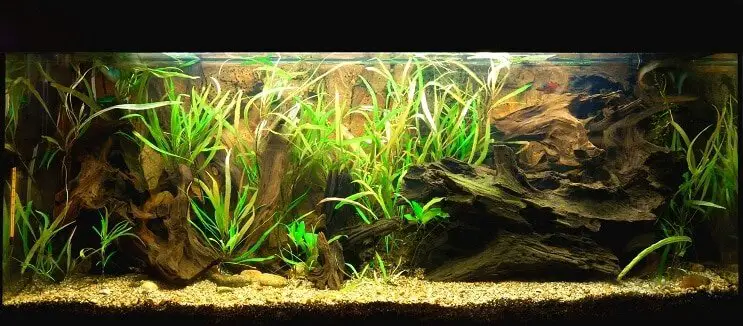
German blue rams are moderately difficult to care for because they’re sensitive to water fluctuations, need specific tank conditions, and are susceptible to fish tuberculosis. Replicating German blue rams’ natural habitat helps them live long, healthy, and happy lives.
German blue rams are omnivores that can be fed a combination of pellets, flakes, vegetables, and live or frozen foods.
Habitat and Tank Requirements
In their natural habitat, German blue rams live in soft, acidic, slow-moving water that’s sheltered from light and stained from decaying leaf litter. Dense vegetation, and plenty of spots where the fish can take refuge, help the species feel safe.
German blue rams are active fish that require a 20-gallon tank or larger. The water must be kept between 80°F and 86°F and on the acidic side.
To simulate the German blue ram’s wild habitat, set up various hiding spots throughout the tank with caves, driftwood, and plants, and keep the lighting dim. Add sterilized leaf litter at the top of the tank and avoid filtration systems that generate strong currents. Use a dark-hued, soft substrate to bring out the German blue ram’s vibrant coloration.
While the German blue ram loves hiding spots, the fish still needs plenty of open space to roam around and explore.
Tank Conditions
| Water type: | Freshwater, with weekly partial water changes (at 25%). Heavily-stocked aquariums require more frequent water changes. Ensure the water parameters are stable |
| Tank size: | Minimum 20 gallons for one German blue ram, increase tank size by 5 gallons per additional fish |
| Water temperature: | 80–86°F (26–30°C) |
| Substrate: | Fine sand substrate. Dark coloration shows off the fish’s coloration |
| Tank setup: | Should simulate natural habitat, meaning plenty of plants and hiding spots. Create hiding spots with driftwood, caves, and rocks, but don’t overcrowd the tank. Scatter sterilized leaf litter at the top of the tank. Replace the leaf litter every few weeks to prevent the tank from becoming dirty |
| Acidity: | 5.0–7.0 pH |
| Water hardness: | 6–14 dGH |
| Filter: | Necessary to keep ammonia and nitrate levels low. Opt for a gentle filtration, or disperse a strong current with decorations |
| Lighting: | Dim. Floating plants can be used to diffuse harsh lighting |
| Plants: | Hardy plants that can live in similar water conditions |
Monitor the water daily with a thermometer and pH meter. German blue rams get stressed and sick if water conditions aren’t ideal.
Disease
German blue rams are particularly prone to a rare but lethal condition known as fish tuberculosis. This infectious disease causes lethargy, scale loss, lesions, and wasting flesh. Fish tuberculosis is highly contagious and can even spread to humans, though the disease is rarely fatal in humans.
Fish tuberculosis isn’t curable in fish but can be prevented by keeping the water clean, quarantining new fish for two to three weeks, and sterilizing decorations.
German blue rams are also susceptible to common freshwater ailments like ich, fin rot, and skin flukes.
- Ich: A parasitic infection caused by Ichthyophthirius multifiliis. Symptoms include white spots on the body, lethargy, and the fish rubbing itself against objects in the tank (flashing). Quarantine fish with ich immediately and increase the water temperature gradually to accelerate the parasite’s life cycle
- Fin rot: A bacterial or fungal infection that causes the fish’s fins and tail to become discolored, ragged, and inflamed. Fin rot must be treated with antibiotics
- Skin flukes or Trematoda: Parasites that feed on the fish’s skin and gill tissue, causing flashing, clamped fins, irritation, and appetite loss. Skin flukes are treatable with antiparasitic medication
Tank Mates
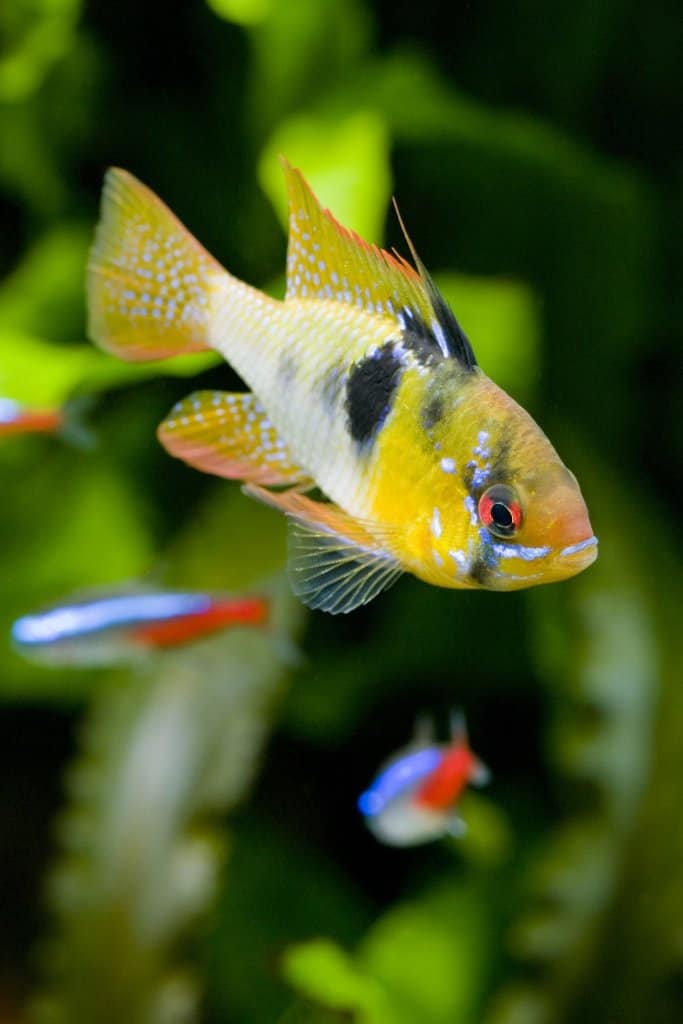
The German blue ram is a peaceful, even-tempered fish that gets along well with similar-sized, docile species. Tankmates should share the same habitat preferences. Avoid fish that are boisterous, large, or aggressive.
Great tank mates for German blue rams include:
- Silver dollar fish
- Dwarf gouramis
- Bristlenose plecos
- Kuhli loach
- Peaceful tetras, like the cardinal tetra and neon tetra
- Corydoras
Diet and Feeding
German blue rams are omnivores. In the wild, these fish’s diet consists of plant material, insects, and small invertebrates.
Replicate the German blue ram’s wild diet in captivity with pellets, flakes, and the occasional leafy vegetable. Live and frozen foods help bring out the fish’s coloration. Suitable live and frozen foods include brine shrimp, cyclops, and bloodworms. Food should be small enough to fit into the German blue ram’s mouth.
Feed adult German blue rams once a day, giving them only what they can finish within three minutes. Fishkeepers can also separate this food into pinch-sized portions, spread out throughout the day, to help maintain water quality.
Breeding
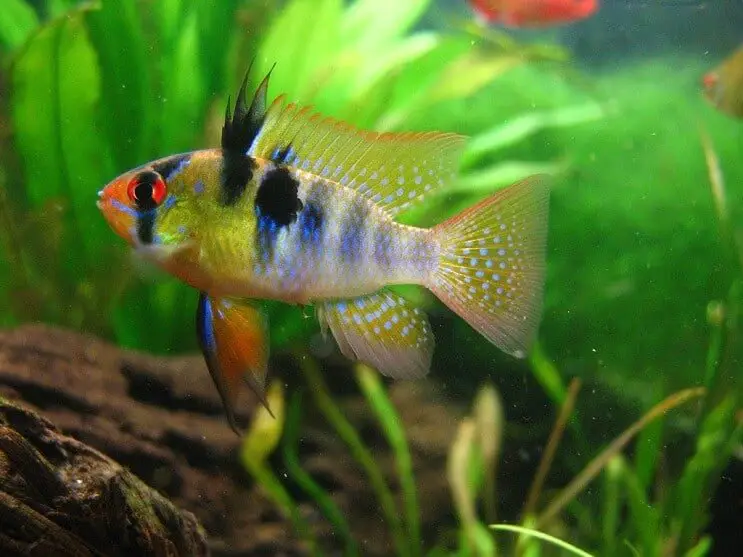
German blue rams are relatively easy to breed. These fish lay between 150 and 200 eggs on average and readily form pairs. To breed German blue rams, follow the steps below:
- Feed the breeding pair a protein-rich diet consisting of live and frozen foods to prepare them for the spawning process
- Set up a separate 10-gallon breeding tank with a sponge filter and plenty of surfaces for the female to lay her eggs on. Smooth rocks and wide leaves are ideal surfaces. Keep the temperature on the warm side, at 82°F to 86°F, and the pH between 5.8 and 6. The water should be soft
- During spawning, the female lays her eggs while the male follows and fertilizes them. German blue rams typically fan their eggs and guard them until they hatch. However, some German blue rams won’t hesitate to eat the eggs and these fish be removed immediately
- Eggs hatch within 60 hours. Once the fry are free swimming, feed them microworms, infusoria, or newly-hatched brine shrimp
Should You Get a German Blue Ram for Your Aquarium?
German blue rams are peaceful, social, and attractive fish that make wonderful additions to community aquariums. This species can even learn to recognize its owners.
The German blue ram is sensitive to water fluctuations and, therefore, does best with an experienced fishkeeper who knows how to keep water parameters stable and ammonia and nitrate levels low.
You shouldn’t get a German blue ram if you’re new to fishkeeping, house aggressive, large, or boisterous species in the tank, or can’t provide the fish with a varied diet.
With proper care, German blue rams will keep you entertained with their eye-catching coloration, unique swimming style, and playful behavior.

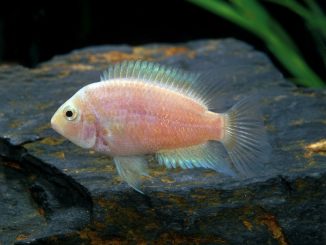
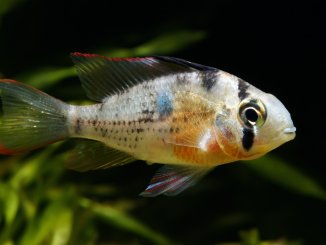
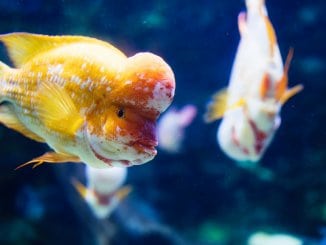
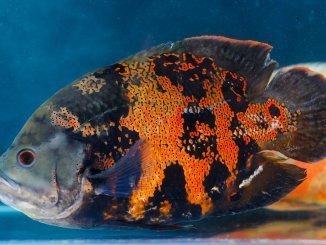
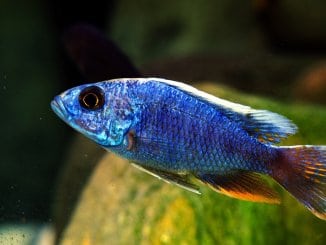
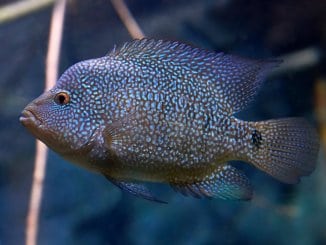

I have a newly seasoned tank, nitrites 0, ammonia 0 and nitrates around 30.
I plan on picking up a pair of Rams today. Also looking for Flame Gourami to add later. 3 or 4 Kuhli Loaches and a small algae eater will round out the show.
I’ve had some of these German blue rams and their mouths get red and puffed up like round. They don’t eat and die shortly after noticing this. Any suggestions?
My rams seem to be doing fine eating etc
Problem is they don’t seem to be growing
??Any Ideas
That is a fluke it is a parasite that lives in the gills of fish and can be treated using prazzipro